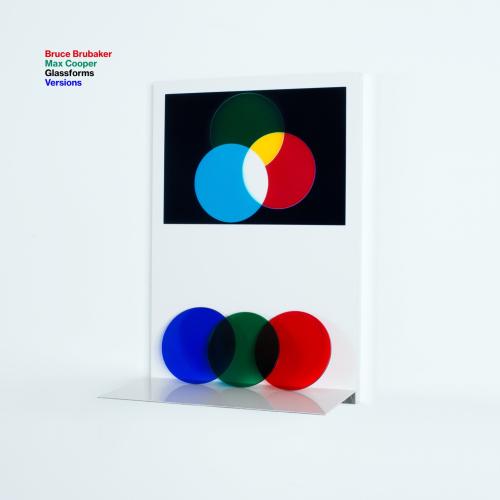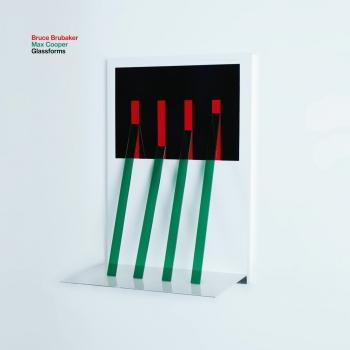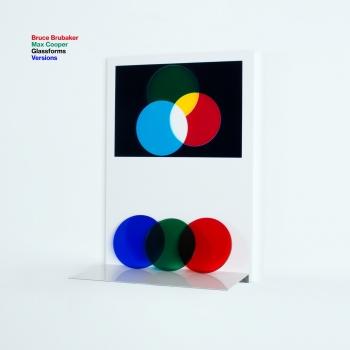
Glassforms Versions Bruce Brubaker & Max Cooper
Album info
Album-Release:
2021
HRA-Release:
29.01.2021
Album including Album cover
- 1 Two Pages (Donato Dozzy & Daniele Di Gregorio Variation) 08:56
- 2 Opening (Laurel Halo Version) 05:54
- 3 Two Pages (Tegh Version) 08:32
- 4 Opening (Glassforms Version Edit) 04:40
- 5 Two Pages (Glassforms Version Edit) 06:18
Info for Glassforms Versions
Bruce Brubaker
was presented by Carnegie Hall in New York, at the International Piano Festival at La Roque d’Anthéron, at Michigan’s Gilmore Festival, by the St. Louis Symphony at the Sheldon, at the Philharmonie de Paris, and at Boston’s Institute of Contemporary Art, as opening-night performer in the museum’s acclaimed Diller Scofidio + Renfro building. He is a frequent performer at New York City’s Le Poisson Rouge, and at Folle Journée in Nantes.
Bruce Brubaker is featured on Nico Muhly’s album Drones (Bedroom Community). Along with pianist Ursula Oppens, Brubaker made Piano Songs, a recording of Meredith Monk’s piano music, including four new transcriptions by Brubaker, released by ECM. Brubaker’s newest recording of solo piano music by Philip Glass (Glass Piano) for InFiné (Warp Records) was remixed by six artists on Glass Piano: Versions. The album Codex (InFiné) includes music from the 15th-century Codex Faenza and music by Terry Riley.
Brubaker’s albums for Arabesque include Time Curve (music by Glass and William Duckworth), Hope Street Tunnel Blues (music by Glass and Alvin Curran, featuring Brubaker’s transcription of a portion of Einstein on the Beach), Inner Cities (including a live recording of John Adams’s Phrygian Gates and Brubaker’s transcription of part of Adams’s opera Nixon in China), and the first album in the series, glass cage, named one of the best releases of the year by The New Yorker magazine.
Brubaker has premiered works by Glass, Meredith Monk, Nico Muhly, Mark-Anthony Turnage, Oliver Lake, Butch Rovan, Simon Hanes, and John Cage. He performed at Sanders Theater in collaboration with Cage during the composer’s tenure as Charles Eliot Norton Lecturer at Harvard University.
Following his New York debut at Lincoln Center’s Alice Tully Hall, Brubaker was awarded a solo artist grant from the National Endowment for the Arts. He was named “Young Musician of the Year” by Musical America. His London debut at the Wigmore Hall led to his first broadcast concert on the BBC, an all-Brahms recital. Brubaker has appeared at Lincoln Center’s Mostly Mozart Festival, the Hollywood Bowl, Tanglewood, London’s Wigmore Hall, Leipzig’s Gewandhaus, Antwerp’s Queen Elizabeth Hall, Finland’s Kuhmo Festival, and Geneva’s “Antigel.”
Bruce Brubaker appeared on Arté in a live broadcast with Francesco Tristano, from the Gaîté Lyrique in Paris, and is featured in the documentary film about the Juilliard School, made for the PBS “American Masters Series.” He appears in Sandra Trostel’s 2015 film Everybody’s Cage. As a member of Affiliate Artists Xerox Pianists Program, he presented residencies and performed with orchestras throughout the United States.
Brubaker has given presentations, masterclasses, and forums at the Juilliard School, the Royal College of Music in London, the United Nations, the Guildhall School in London, Central Conservatory in Beijing, Helsinki’s Sibelius Academy, the Jerusalem Academy of Music and Dance, Harvard University, Columbia University, the Institute for Advanced Study in Princeton, Leipzig’s Hochschüle für Musik, the École Normale in Paris, Ghent’s Orpheus Instituut, Indiana University, North Carolina’s Eastern Music Festival, and the San Francisco Conservatory of Music.
Brubaker’s articles about music have appeared in The Wall Street Journal, USA Today, Piano Quarterly, Perspectives of New Music, Dutch Journal of Music Theory, Parse, and Chamber Music magazine. He was co-editor and a contributor to Pianist, Scholar, Connoisseur: Essays in Honor of Jacob Lateiner (Pendragon Press, 2000), a collection paying homage to his former teacher. His essay “Time Is Time” appears in Unfolding Time (2009), available in the U.S. from Cornell University Press. He presented the closing recital in Harvard University’s Crosscurrents conference in 2008.
Brubaker was the creator of “B-A-C-H,” a six-concert series in New York examining music of J. S. Bach and composers who followed. In New York, Brubaker organized “Piano Century,” in which 100 pianists performed 101 twentieth-century pieces in eleven concerts. Brubaker created and performed Pianomorphosis, a 70-minute multidisciplinary performance piece for the Gilmore International Keyboard Festival. Brubaker’s performance piece Haydnseek, was created together with Nico Muhly. Brubaker is the founder and artistic director of the chamber music festival SummerMusic in his native Iowa.
Max Cooper
Strip away the awe-inspiring AV spectacles, the peak-time DJ voyages in front of huge crowds the world over, the lofty certifications bestowed upon him by platforms of both academia and electronica – at the core, Max Cooper’s mission as a musician, a DJ and an interdisciplinary artist is all about provoking a greater understanding. So why is the man himself a touch misunderstood?
For once, this is a case of scaling down, rather than up. There is no need to over-play the hand; Max Cooper has been a prominent culture figure of the 2010s. Few have been so successful in interrogating and furthering the intersection between electronic music, visual art, technology and science in the past ten years. As a DJ and live performer, he has featured at nearly every major festival and club that one could list. An instalment in the BBC Essential Mix series; a Cercle livestream inside the Musee Bourdelle that reached hundreds of thousands of fans; ‘Glassforms’, a reinterpretation of Philip Glass’ work; and even a collaboration with Zaha Hadid Architects, mapping projections onto an 18th century castle, variously speak to his thrum of high-profile activity in recent years. Cooper has an arms-length wingspan of achievement. Yet the grand question that keeps his mind ticking as the 2020s begin is, in his own words, “a question of communication.”
Cooper wants to present a diverse palette of experiences without diminishing them – to show you his world on multiple levels, without it ever appearing daunting. And it shouldn’t be daunting: Cooper’s music is lush, emotive and grand, and the way he brings this to life, using everything from binaural sound positioning to 360˚ visual panelling, is meticulous, technical and often powerful to behold. But all the elements are highly accessible. You could, after all, walk through the Aether installation Cooper worked on with Architecture Social Club, or feel the ripples on your fingers when 4DSOUND speakers pushed swells of bass and soaring arpeggios outward from his equipment and into the physical space.
All this adds up to a classic case of electronic exploration that makes use of available technology while referencing that which came before it, and does so in a human way. Cooper points to the groundbreaking artistry of Chris Cunningham’s music videos, and the marriage of score and cinematography in the motion picture Koyaanisqatsi, as blueprints for what he sets out to achieve. “There are often no characters and no speaking, it’s just really impactful storytelling through the medium of abstract visuals and audio,” he says. “That is what I fundamentally aim for. I want to communicate something strong. I want to make an impact on people. And if something is fruitful, I am keen to learn. It’s all a matter of trying as much as possible.”
Yearning for the Infinite, his fourth studio album, is another rich attempt to throw a cast net over this innate curiosity. The project arose through an invitation from The Barbican, asking Cooper to respond to their 2019 theme of “Life Rewired.” On the resultant LP, he continues to till the fertile land of “big chord progressions and micro-glitch detailing” that captivated listeners across previous albums Human, Emergence and One Hundred Billion Sparks. On Yearning, Cooper places more trust in intuition and improvisation than before. Musical parameters are set but non-repeating loops, melodic squiggles and ultra-dense layering of channel help him colour outside the pre-defined lines. One song is a rocket of ecstatic release, the next as still and disquieting as a will-o’-the-wisp. The variation ensures the 50th listen is as rewarding as the 1st.
Ideated and developed in individual chapters, Cooper’s preferred method, and with a number of longstanding collaborators such as film-maker Nick Cobby and mathematician Andy Lomas continuing to work alongside him, the project extends his overarching goal to reach for the sublime and help his audience get there too. Where previous full-length have explored the birth of the universe, the formation of natural law and the inner workings of the mind, Yearning for the Infinite once again deals with immense topics. Placed together, the audio, filmic and concomitant web media speak of parallax, Penrose tiling and the folly of perpetual growth. There is a red line in Cooper-world over hammering the phrase ‘immersive’, but this does the job rather well. As much as Cooper’s shows are an immersion of sound and vision, his projects are an overall immersion of concept. He wants to reach for the sublime, and, critically, help you get there.
This chameleonic quality in his output lends him to varying situations: a viable headliner for both The Barbican and Bangface in the same calendar year, as Cooper wryly points out. A sharp set of hands on the turntables from younger years in Belfast and Nottingham, he still remains as excited about the possibilities of applying himself to warehouse technos circa 7am as high-minded art expos at 7pm. “Both are valid,” and he gives short shrift to those who play gatekeeper at the invisible walls between them. The mutual power, he says, “comes in the fact that both can totally remove you from your normal experience of reality and put you somewhere new. That can be an intense sort of artistic experience.” And this gets to the root of Cooper’s approach.
You don’t need a PhD or an encyclopaedic knowledge of the works of Philip Glass to invest in Max Cooper – that is the opposite of his intention. What drives Cooper forward in a state of “Perpetual Motion” is making these great intangibles tangible: to plant a kernel of an idea or a feeling in your body, and then develop that in real time through creative storytelling that defies format. He can scrape the cosmos and divine the near future of art and science’s convergence, and he can do it with a dynamic piece of recorded audio or just a few absorbing frames of film.
“If I put something into the world that represents me,” Cooper says, “then it renders my soul in a more solid form for others.” As an accomplished artist, Cooper has reached a point where he can apply his craft to something more timeless: to break off a piece of himself and let it become a piece of his audience, forming a human connection that lingers long after the screens go black and the synths stop humming. For someone who appears outwardly so sorted, a master of his specific domain, Cooper is in a mode of challenging himself anew. The synthesis of interests continues, but the overall questing has taken on an added importance. “People perceive it as a challenge, maybe even a problem,” Cooper smiles. “I think it’s wall to try and knock down though, you know?” (Written by Gabriel Szatan)
This album contains no booklet.










